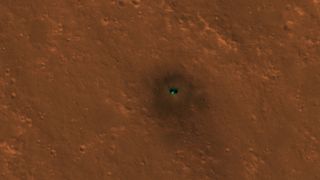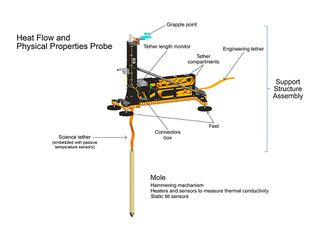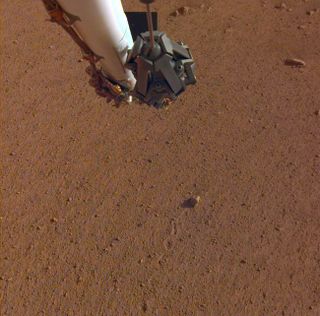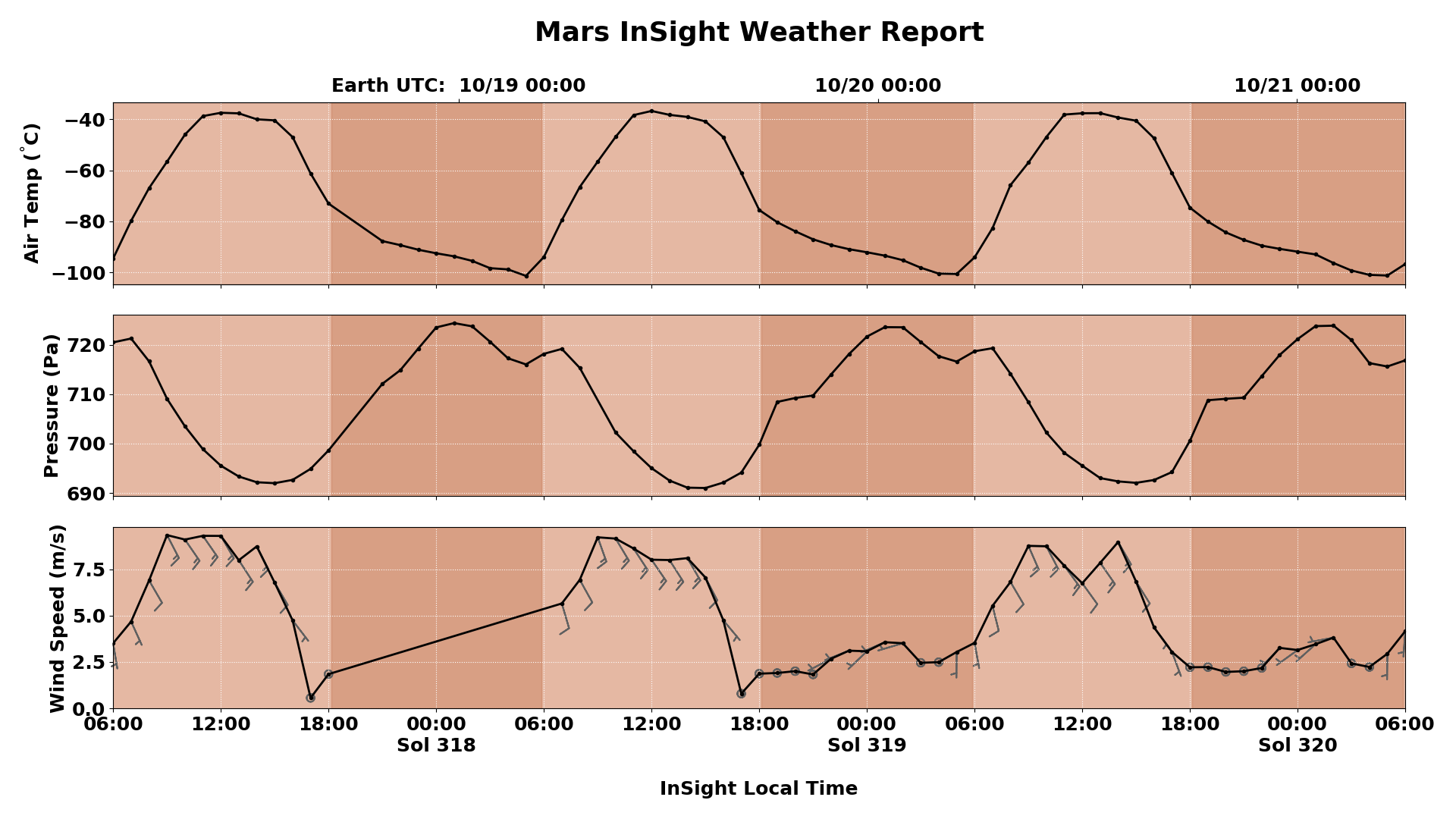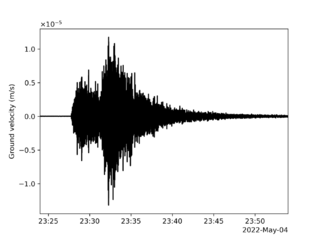Difference between revisions of "InSight Mission"
(→Mission Discoveries: added image) |
|||
| Line 116: | Line 116: | ||
<gallery class="center" widths="380px" heights="360px"> | <gallery class="center" widths="380px" heights="360px"> | ||
File:Newcraterctxbeforeafter.jpg|Before and after pictures of site where the new crater was formed. Pictures are from CTX. | File:Newcraterctxbeforeafter.jpg|Before and after pictures of site where the new crater was formed. Pictures are from CTX. | ||
| − | File:Newcratericesize.jpeg|Close view of new crater, as seen by HiRISE. Sizes are indicated. | + | File:Newcratericesize.jpeg|Close view of new crater, as seen by HiRISE. Sizes are indicated. White dots are boulder-sized chunks of ice that were blown out by the impact. |
</gallery> | </gallery> | ||
Revision as of 07:57, 28 October 2022
NASA’s Interior Exploration using Seismic Investigations, Geodesy and Heat Transport (InSight) made a soft landing as planned on November 26, 2018 at 4.502 °N, 135.623 °E. InSight landed in a crater that is 25 meters in diameter Homestead hollow. This crater is filed with sediments from impacts. The sediments have been modified and transported by wind.[1]
It is the first space robotic explorer to study the inside of Mars: its crust, mantle, and core. It set down at exactly 2:52:59 p.m. EST. We found out about the landing by way of two small experimental Mars Cube One (MarCO) CubeSats. They were launched on the same rocket as InSight and relayed information from the lander. [2] The launch took place with an Atlas V-401 from Vandenberg Air Force Base, California on May 5, 2018 7:05 a.m. ET. It’s main instruments are a seismometer (SEIS), a heat probe, and a radio science instrument (RISE).[3]
See the Interior of Mars for more information of Mars' structure.
Artist’s conception of Insight lander sitting on Mars with instruments deployed
The red dot shows where InSight landed. It landed just about in the center of its landing ellipse. The location is in the Elysium quadrangle at about 4.5 N and 135.6 E (224.4 W).
Contents
Spacecraft
InSight weighs 794 pounds (360 kilograms). It is 19 feet 8 inches (6 meters) with solar panels deployed ("wingspan"), and its deck is 5 feet 1 inch (1.56 meters) in diameter.[4] Since dust covering solar panels is a persistent problem for Mars missions, the solar panels on InSight are about two times larger than necessary.
Mission Activities
December 19, 2018, InSight's seismometer was set onto the ground directly in front of the lander, about as far away as the arm can reach ---- 5.367 feet. Principal Investigator Bruce Banerdt, stated "The seismometer is the highest-priority instrument on InSight: We need it in order to complete about three-quarters of our science objectives." The seismometer allows scientists to peer into the Martian interior by studying ground motion — also known as marsquakes. Each marsquake acts as a kind of flashbulb that illuminates the structure of the planet's interior. By studying how seismic waves pass through the layers of the planet, scientists can deduce the depth and composition of these layers.[5] InSight's seismometer is so sensitive that if Mars had an atmosphere, and a butterfly landed on the seismometer it's vibrations would be detected. It can detect ground motion that is only half the width of a hydrogen atom.
On February 13, 2019, NASA announced that the InSight lander has placed its second instrument on the Martian surface. New images confirm that the Heat Flow and Physical Properties Package, or HP3, was successfully deployed on Feb. 12 about 3 feet (1 meter) from InSight's seismometer. HP3 measures heat moving through Mars' subsurface.
Equipped with a self-hammering spike, mole, the instrument will burrow up to 16 feet (5 meters) below the surface, deeper than any previous mission to the Red Planet. This compares to, the Viking 1 lander which went down 8.6 inches (22 centimeters). While the Phoenix lander dug down 7 inches (18 centimeters).
HP3 looks a bit like an automobile jack but with a vertical metal tube up front to hold the 16-inch-long (40-centimeter-long) mole. A tether connects HP3's support structure to the lander, while a tether attached to the top of the mole features heat sensors to measure the temperature of the Martian subsurface. Meanwhile, heat sensors in the mole itself will measure the soil's thermal conductivity, that is how easily heat moves through the subsurface.
The mole will stop every 19 inches (50 centimeters) to take a thermal conductivity measurement of the soil. Because hammering creates friction and releases heat, the mole is first allowed to cool down for a good two days. Then it will be heated up by about 50 degrees Fahrenheit (10 degrees Celsius) over 24 hours. Temperature sensors within the mole measure how rapidly this happens, which tells scientists the conductivity of the soil. If the mole encounters a large rock before reaching at least 10 feet (3 meters) down, the team will need a full Martian year (two Earth years) to filter noise out of their data. This is one reason the team carefully selected a landing site with few rocks and why it spent weeks picking where to place the instrument.[6]
In May 2021, the InSight team boasted the power output of the solar cells with a novel method. By using the scoop to drop sand grains on the panels, they raised the power by 30 watt-hours. When there was maximum wind, they caused sand to fall and then bounce along on the solar panels. The larger grains carried off the smaller dust particles in the wind. A big drawback to using solar panels on Mars is that they get covered with dust. However, sometimes we get lucky because passing dust devils clean the panels.[7]
Mission Discoveries
InSight's seismometer recorded its first marsquake on April 6, 2019, and its largest seismic signal to date at 7:23 p.m. PDT (10:23 EDT) on May 22, 2019. That last event is believed to be a marsquake of magnitude 3.0.[8] [9] NASA's Mars InSight lander has measured and recorded for the first time ever a likely "marsquake." This is the first recorded vibration that seems to have originated inside Mars. It's greater duration is similar to that of moonquakes detected on the lunar surface during the Apollo missions,"said Lori Glaze, Planetary Science Division director at NASA Headquarters. Sismometers that measured thousands of quakes while operating on the Moon between 1969 and 1977, revealing seismic activity on the Moon.[10] As of October 2019. Insight has found 21 Marsquakes.[11] [12]
As summary of Insight's first Martian year of operation reported that there were more than 450 events that appear to be of tectonic origin. Three events had magnitudes between 3.1 and 3.6 and were at distances between 27.5° and 47° (±10°) from the lander. They originating in the Cerberus Fossae region.[13]
The marsquakes measured by insight have led scientists to conclude that the three biggest events were from the Cerberus Fossae region. It is located about 1’500 km away. The tectonic graben system at Cerberus Fossae is caused by the great mass of Elysium Mons, a volcano in the Elysium Planitia region. Mars has a total seismic energy between that of the moon and the Earth.[14] [15] [16] [17] The top 8–11 km of the crust is highly altered and/or broken.[18] All of the seismic event found so far are of tectonic origins--none were the result of impacts.[19]
Mars soil is strange--very cohesive. Holes dug on Mars showed no lip; it seems the soil was just pounded into the ground.[20]
Insight has detected dust devils with the weather station.
On 28 February 2019, the Heat and Physical Properties Package probe (HP³) started its drilling into the surface of Mars. The probe and its digging mole were intended to reach a maximum depth of 5 meters (16 ft) about two months after, but on 7 March 2019, the HP³ instrument's mole paused its digging. The mole had only gone down to about 35 cm (14 in)[21]
At first, it was thought that maybe the mole hit a rock--that would have been hard to deal with. But in October 2019, scientists at JPL concluded that the mole could not go any farther because the soil on Mars does not provide necessary friction for drilling. Hence, the mole bounces around and makes a wide pit around itself instead of digging deeper. However, they devised a manoeuvre called "pinning" in which they press the side of the scoop against the mole to try and pin it to the side of the wall of the hole to increase friction to stop it from moving forward while digging.[22] NASA reported that the pinning worked.[23]
NASA has gave up trying to deploy a heat flow probe in January, 2021. Almost two years of trying different approaches did not work. The team attempted to push down the mole with the scoop on the end of the lander’s robotic arm to prevent it from rebounding. They tried to tamp down regolith around the hole. They filled in the widening hole so the mole could gain more friction, but nothing worked.[24] [25]
On December 16, 2020, NASA reported that InSight had detected more than 480 quakes in a
little more than one Martian year after landing. However, none had greater than a 3.7 magnitude and none exhibited surface waves--only P and S waves. The lack of surface waves could be due to extensive fracturing in the top 6 miles (10 kilometers) below the lander. Or it could also mean that the quakes InSight detected are coming from deep within the planet. Deep quakes do not make strong surface waves.[26]
By March, 2021, Insight had detected about 500 events, according to Philippe Lognonné, principal investigator.[27]
The timing of the quakes was a bit unusual. Once InSight began hearing quakes, they occurred every day. Then, in late June, quakes stopped. Just five quakes have been detected since then, all of them since September. Experts think Mars' wind is responsible for these seismically blank periods. The time when no quakes were measured was the windiest season of the Martian year. This idea is supported by the fact that it took a while before any quakes were found and that was also a windy time for a regional dust storm was finishing up.[28]
Journal articles published in July 2021 in the journal Science detailed what has been learned about the Martian interior to date. Its crust is probably 24- to 72-kilometers thick, while its lithosphere is about 500 kilometers thick. Like the Earth, Mars has a low-velocity layer under its lithosphere. The Martian crust is highly enriched (13 to 20 times as much) in radioactive elements that help to heat this layer, but at the expense of the interior. In other words, these heat producing elements lie more in the crust than in the deeper interior. Mars has a large (1830 kilometer) liquid core.[29] [30] [31] [32] [33] The core has an average density of 5.7 to 6.3 grams per cubic centimeter. To achieve that density means that a great deal of light elements must be dissolved in an iron-nickel core. The number of Marsquakes that were detected was problably reduced by a large seismic core shadow as seen from InSight’s position on the planet. It would have been difficult to find quakes near Tharsis. Tharsis contains many huge volcanoes, including Olympus Mons. One might expect this region to produce many quakes, but they can not be found by InSight.[34] [35] Quakes have an area where waves can't pass through; hence, we can't observe earthquakes form that region. To be technical, it is the angular distances of 104 to 140 degrees from a given earthquake. In that area, S waves are being stopped by the liquid core and P waves are being bent or refracted, by the liquid core.[36]
Mission scientists said that one 4.2-magnitude earthquake struck roughly 8,500 kilometers (5,280 miles) from InSight in August. This is much farther than the other quakes.[37] Furthermore, it lasted for almost an hour and a half.[38]
A large research team announced that they had determined details of the Martian the subsurface to about a depth of 200 m. Right beneath the surface is a 3 meter regolith layer of sandy material. Next, there is a 15 meter layer of blocky ejecta that came from past impacts. Under the blocker layer is a basalt lava flow. Between lava flows is a layer of sedimentary material. The upper basalt layer is of Amazonian age--about 1.7 billion years old. The lower basalt layer is of Hesperian age (3.6 billion years old).[39] [40] The researchers used the faint vibrations induced by Martian winds to discover the subsurface structure.[41]
In an abstract released in February of 2022. researchers described what had been learned from InSight at that time--after almost 1000 Marsquakes had been detected. The crust is 20-35 km thick under insight.[42] [43] [44] [45] Seismic velocity was 7.8 Km/sec. The core has a radius of 1830 Km and a density of 6000 Kg/m cubed.[46] [47] [48] [49]
In May, 2022, NASA announced that InSight detected the largest quake ever detected on Mars; it had an estimated magnitude of 5. This temblor occurred on May 4, 2022, the 1,222nd Martian day. Insight has observed more than 1,313 quakes since landing in November 2018. The largest previously recorded quake was an estimated magnitude 4.2 detected Aug. 25, 2021.[50]
Types of troughs in Cerberus Fossae near where InSight has detected Marsquakes
Research published in August, 2022 suggested that "uncemented material" largely fills in the region under InSight. That implies that little water is present. Although the ground has much pore space, the pore spaces probably are largely just full of air, rather than ice or other cementing material. It was thought that perhaps there could be ice- or liquid water-saturated layers within the upper 300 m beneath InSight, but this study shows that is not the case. Had there been cement between soil particles, it has likely been broken by impacts or marsquakes. InSight measures the speed of seismic waves within the crust. These velocities change depending on rock type and the material that fills the pores within rocks. Hence, the amount of pore space can be measured. The velocity of these waves would be different going through ice or air.[51] [52] [53]
NASA announced on September 19, 2022 that Insight had detected audio and seismic waves from an impact. In other words, they heard the impact. Researchers calculated where the impact happened, and then found the resulting craters with CTX and HiRISE. The body entered Mars’ atmosphere on Sept. 5, 2021. It then blew apart into at least three pieces. Each of them made a crater. Scientists studied the seismic recordings to see what an impact event looks like. They were then able to discover three other impacts that occurred on May 27, 2020; Feb. 18, 2021; and Aug. 31, 2021. The size of the quakes produced by these impacts was small--no more than magnitude 2.0.[54] [55] [56]
The sound can be heard at https://www.youtube.com/watch?v=439Hg8aAars
On October 27, 2022, NASA described a new impact that was seen with orbiting cameras and detected by Insight. This discovery was published in the journal Science. The impacting body is estimated to have been 16 to 39 feet (5 to 12 meters) across. It would have burned up in Earth’s atmosphere. The crater produced by the impact was larger than a football field and was 70 feet (21 meters) deep. Pieces of ejecta flew as far as 23 miles (37 kilometers) away.
The impact happened on December 24, 2021 and was measured to have made a marsquake of magnitude 4 by InSight. This may have been the largest impact that has ever been observed. Chunks of ice that were excavated were the biggest ever found this close to the equator. That's good news for future colonists--maybe ice is more widespread than previously thought.[57]
References
- ↑ Banerdt B et al.: Initial results from the InSight mission on Mars, Nature Geoscience, 24 February 2020, doi: 10.1038/s41561-020-0544-y
- ↑ https://mars.nasa.gov/news/8392/nasa-insight-lander-arrives-on-martian-surface/?site=insight
- ↑ https://mars.nasa.gov/insight/spacecraft/instruments/summary/
- ↑ https://mars.nasa.gov/insight/spacecraft/about-the-lander/
- ↑ https://mars.nasa.gov/news/8402/nasas-insight-places-first-instrument-on-mars/?site=insight
- ↑ https://www.jpl.nasa.gov/news/news.php?feature=7335&utm_source=iContact&utm_medium=email&utm_campaign=nasajpl&utm_content=daily-20190213-4
- ↑ https://www.jpl.nasa.gov/news/nasas-insight-mars-lander-gets-a-power-boost?utm_source=iContact&utm_medium=email&utm_campaign=nasajpl&utm_content=daily20210603-3
- ↑ https://outlook.live.com/mail/inbox/id/AQMkADAwATExAGNiNy00YzQ1LTM4MjMtMDACLTAwCgBGAAADdsmEa%2FgtIEmBK%2FX8yb671wcAkr%2FaXi2mwEKimhNbcs0ITQAAAgEMAAAAkr%2FaXi2mwEKimhNbcs0ITQACxRb2xwAAAA%3D%3D
- ↑ https://www.jpl.nasa.gov/news/news.php?feature=7383&utm_source=iContact&utm_medium=email&utm_campaign=nasajpl&utm_content=daily-20190605-1
- ↑ https://www.jpl.nasa.gov/news/news.php?feature=7383&utm_source=iContact&utm_medium=email&utm_campaign=nasajpl&utm_content=daily-20190605-1
- ↑ https://www.space.com/mars-insight-lander-burrowing-probe-hope.html?utm_source=Selligent&utm_medium=email&utm_campaign=8763&utm_content=20191016_SDC_Newsletter+-+adhoc+&utm_term=2946561&m_i=pAsrLmboNLkM3OHTeP4JZwcN0DgadelbQged0iUjw8q_smkwBFQbBTBN4arp5CfWSRZEdakPqW36HVks02yDLWEFGsm9W%2Bsppz
- ↑ https://www.universetoday.com/143625/insight-has-already-detected-21-marsquakes/
- ↑ Panning, M., et al. 2021. RESULTS FROM INSIGHT’S FIRST FULL MARTIAN YEAR. 52nd Lunar and Planetary Science Conference 2021 (LPI Contrib. No. 2548). 1533.pdf
- ↑ https://ethz.ch/en/news-and-events/eth-news/news/2020/02/seismicity-of-mars.html?fbclid=IwAR0HwOkxqG_QmBNn62TxW8yMKZDDNAtfB2LEIHGZ4zNvIjbGD8wFWZJaI6k
- ↑ Banerdt B et al.: Initial results from the InSight mission on Mars, Nature Geoscience, 24 February 2020, doi: 10.1038/s41561-020-0544-y
- ↑ Giardini D et al.: The seismicity of Mars. Nature Geoscience, 24 February 2020, doi: 10.1038/s41561-020-0539-8
- ↑ Lognonné P et al.: Constraints on the shallow elastic and anelastic structure of Mars from InSight seismic data. Nature Geoscience, 24 February 2020, doi: 10.1038/s41561-020-0536-y
- ↑ Lognonné P et al.: Constraints on the shallow elastic and anelastic structure of Mars from InSight seismic data. Nature Geoscience, 24 February 2020, doi: 10.1038/s41561-020-0536-y
- ↑ Banerdt B et al.: Initial results from the InSight mission on Mars, Nature Geoscience, 24 February 2020, doi: 10.1038/s41561-020-0544-y
- ↑ https://www.space.com/mars-soil-weird-nasa-insight-lander.html?utm_source=Selligent&utm_medium=email&utm_campaign=9036&utm_content=20191022_SDC_Newsletter+-+adhoc+&utm_term=2946561&m_i=6BJGMRJ6hO865ajoAYi4Nmpcq_wRcyNG4CEPalniT_t4eiV%2B%2BNyldqilky%2BFCzep%2BIlvwPHsKTQcyrSLTwmD0ToRMHgw5jd669
- ↑ [1] Jet Propulsion Lab, NASA. 3 October 2019.
- ↑ [2] Jet Propulsion Lab, NASA. 3 October 2019.
- ↑ https://mars.nasa.gov/news/8529/mars-insights-mole-is-moving-again/
- ↑ https://spacenews.com/nasa-ceases-efforts-to-deploy-mars-insight-heat-flow-probe
- ↑ https://www.jpl.nasa.gov/news/nasa-insights-mole-ends-its-journey-on-mars
- ↑ https://mars.nasa.gov/news/8817/3-things-weve-learned-from-nasas-mars-insight
- ↑ https://www.space.com/insight-mission-mars-core-size-finding?utm_source=Selligent&utm_medium=email&utm_campaign=SDC_Newsletter&utm_content=SDC_Newsletter+&utm_term=2946561
- ↑ https://mars.nasa.gov/news/8817/3-things-weve-learned-from-nasas-mars-insight/
- ↑ https://science.sciencemag.org/content/373/6553/434
- ↑ Khan, A., et al. 2021. Upper mantle structure of Mars from InSight seismic data. Science. Vol. 373, Issue 6553, pp. 434-438 DOI: 10.1126/science.abf2966
- ↑ https://www.technologyreview.com/2021/07/23/1030040/we-just-got-our-best-ever-look-at-the-inside-of-mars/
- ↑ https://science.sciencemag.org/content/373/6553/438
- ↑ Knapmeyer-Endrun, B. et al. 2021. Thickness and structure of the martian crust from InSight seismic data. Science. Vol. 373, Issue 6553, pp. 438-443 DOI: 10.1126/science.abf8966
- ↑ https://science.sciencemag.org/content/373/6553/443
- ↑ Stahler, S. et al. 2021. Seismic detection of the martian core. Science. Vol. 373, Issue 6553, pp. 443-448 DOI: 10.1126/science.abi7730
- ↑ https://earthquake.usgs.gov/learn/glossary/?term=shadow%20zone
- ↑ https://www.sciencetimes.com/articles/33612/20210924/nasa-insight-mars-lander-detects-3-massive-earthquakes-red-planet.htm
- ↑ https://www.techtimes.com/articles/265793/20210924/nasa-insight-lander-mars-quakes-nasa-insight-lander-mars-quakes-magnitude-4-mars-quake-over-1-hour.htm
- ↑ https://scitechdaily.com/nasas-mars-insight-lander-uses-wind-induced-vibrations-to-reveal-the-red-planets-subsurface-layers/
- ↑ Hobiger, M. et al. 2021. The shallow structure of Mars at the InSight landing site from inversion of ambient vibrations. NATURE COMMUNICATIONS | https://doi.org/10.1038/s41467-021-26957-7
- ↑ https://www.msn.com/en-us/news/technology/nasa-mars-lander-makes-1st-ever-map-of-red-planet-underground-by-listening-to-winds/ar-AAR3v7Q?ocid=uxbndlbing,
- ↑ Knapmeyer-Endrun et al., Science, 373, 438-443, 2021
- ↑ Kim et al., J. Geo Mantlephy. Res., Planets, in press, 2022
- ↑ Compaire et al. J. Geophy. Res., Planets, 126, e2020JE006498, 2021
- ↑ Schimmel et al. Earth and Space Science, 8, e2021EA001755, 2021
- ↑ Stähler et al., Science, 373, 443-448, 2021
- ↑ Khan et al., EPSL, 578, 2022
- ↑ https://www.hou.usra.edu/meetings/lpsc2022/pdf/2279.pdf
- ↑ Lognonne, P. et al. 2022. SEIS achievement for Mars Seismology after 1000 sols of seismic monitoring. 53rd Lunar and Planetary Science Conference (2022). 2279.pdf
- ↑ https://www.jpl.nasa.gov/news/nasas-insight-records-monster-quake-on-mars?utm_source=iContact&utm_medium=email&utm_campaign=nasajpl&utm_content=daily20220509-1
- ↑ https://www.msn.com/en-us/news/technology/equatorial-mars-is-surprisingly-dry-nasas-insight-lander-finds/ar-AA10zrBw
- ↑ https://agupubs.onlinelibrary.wiley.com/doi/10.1029/2022GL099250
- ↑ Wright, V., et al. 2022. A minimally cemented shallow crust beneath InSight. Geophysical Research Letters. doi: 10.1029/2022GL099250
- ↑ https://www.nature.com/articles/s41561-022-01014-0
- ↑ Garcia, R.F., Daubar, I.J., Beucler, É. et al. Newly formed craters on Mars located using seismic and acoustic wave data from InSight. Nat. Geosci. (2022). https://doi.org/10.1038/s41561-022-01014-0
- ↑ https://www.jpl.nasa.gov/news/nasas-insight-hears-its-first-meteoroid-impacts-on-mars?utm_source=iContact&utm_medium=email&utm_campaign=nasajpl&utm_content=Daily09192022
- ↑ https://mars.nasa.gov/news/9289/nasas-insight-lander-detects-stunning-meteoroid-impact-on-mars/?s=03&fbclid=IwAR2wjZ6yhSZ1XrU553LOZ8R8jJugkkv79uHMvLkZRqfn03ed_6X8Q-ncj5c
See Also
- Elysium quadrangle
- High Resolution Imaging Science Experiment (HiRISE)
- Interior of Mars
- Geography of Mars
Recommended reading
- Kieffer, H., et al. (eds) 1992. Mars. The University of Arizona Press. Tucson
- JPL Mission to Mars InSight
External links
- Mars InSight Mission
- Mission Control Live: NASA InSight Mars Landing
- How NASA's Next Mars Mission Will Take the Red Planet's Pulse | Decoder
- https://www.hou.usra.edu/meetings/lpsc2022/pdf/2279.pdf InSight Seismology after 1000 sols of seismic monitoring

